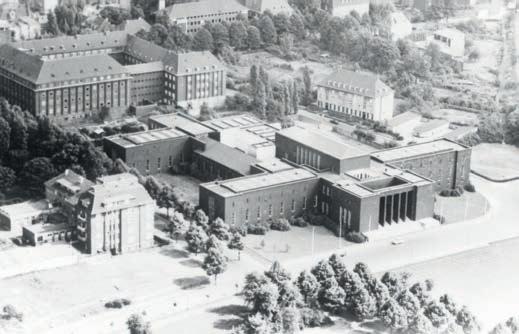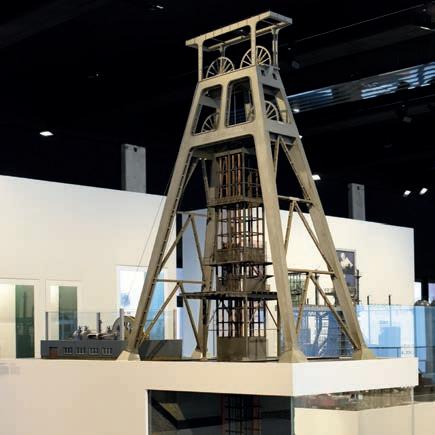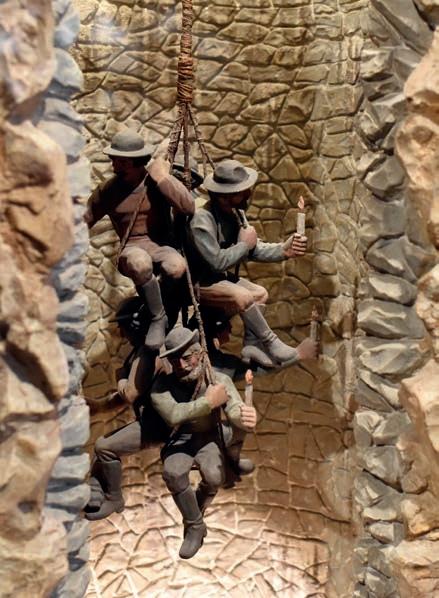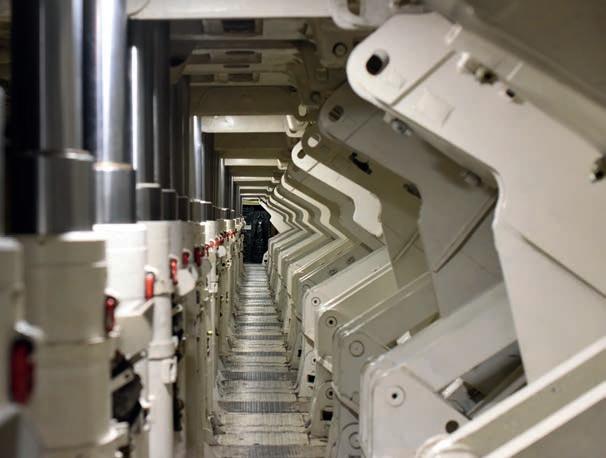
6 minute read
The Deutsches Bergbau-Museum Bochum
The Deutsches Bergbau-Museum Bochum, the Leibniz Research Museum for Geo-resources, was founded on 1 April 1930. From its modest beginnings as a “Historical Mining Museum”, now with over 90 years of history behind it, it has grown to become the world’s largest mining museum. And coal is not the only mined material explored here, for there’s also salt, gold, silver, and copper as well as less common raw materials, such as lithium and molybdenum.
In the middle of the 19th century, mining was one of the most important economic sectors in Germany. In 1868, the Westfälische Berggewerkschaftskasse (WBK) in Bochum, the cooperative venture of the Ruhr mining industry, established a collection of “Mining tools” for teaching and exhibition purposes, to introduce young miners – not the general public – to mining technology and the nature of coal-bearing rock. Plans to found a public mining museum in Bochum were discussed, but were not implemented due to the difficult economic situation prevailing until 1927. Then, however, the city of Bochum and the WBK took the initiative, and Heinrich Winkelmann, a mining engineer who later became the museum’s first director, devised a plan to convert the former abattoir site into a museum. So, the museum is not actually built on the foundations of a former mine, as many visitors assume. The first step was the founding of the museum on 1 April 1930 by the city of Bochum and the Westfälische Berggewerkschaftskasse. The museum was set up in the former cattle slaughterhouse, and was initially run by a director, a master model-maker, and a models custodian. It grew step by step.
Advertisement
After the end of the Second World War, the first tasks were to clean up and carry out repairs, before the first exhibition could be opened in 1946. The visitor‘s mine was reopened to the public in 1948. In 1947 the “Vereinigung der Freunde von Kunst und Kultur im Bergbau e. V.” (“Association of friends of art and culture in mining”) was founded. This organization still actively supports the museum, vigorously promoting a number of activities associated with mining.
Under the museum director Hans Günter Conrad, who took up his position in 1966, the historically oriented museum was expanded and reconfigured as a “research museum”, i. e., a non-university research institution with both national and regional funding. In 1969, the Bergbau-Archiv Bochum (Mining Archive Bochum) was founded. Its aim was to collect, conserve and index evidence of all kinds – written material, files and photos – from the entire German mining industry.


In 1973, the Bergbau-Museum acquired its emblem, the former double headframe taken from the decommissioned “Germania” mine. 71.4 m high and weighing 650 t, the headframe was based on plans drafted by the industrial architect Fritz Schupp. A lift was installed to connect the visitor’s mine, the viewing platform and the museum. By saving the headframe, the Bergbau-Museum triggered a debate about whether technological industrial sites were worth preserving as historical monuments. Since then, the conservation of technological heritage sites has been one of the museum’s research activities. To recognize its importance as a specialist technical museum within the national and international museum landscape, the Bergbau-Museum was renamed on 1 March 1976, becoming the “Deutsches Bergbau-Museum Bochum”.
In 1977, the Deutsches Bergbau-Museum Bochum was recognized as a research museum by the Bund-Länder-Kommission (BLK), and included in the joint national and regional research funding programme. Since then, it has been one of the institutions on the “Blaue Liste” (“blue list”), now known as the Leibniz Association (Wissenschaftsgemeinschaft Gottfried Wilhelm Leibniz e. V., WGL). In 1979, the Deutsches Bergbau-Museum Bochum was admitted to the Arbeitsgemeinschaft außeruniversitärer historischer Forschungseinrichtungen in der Bundesrepublik Deutschland (working group of non-university historical research institutions in the Federal Republic of Germany).
In 2009, an architecturally modern extension, the DBM+, was opened to present special exhibitions in a contemporary manner. Since 2014, the Deutsches BergbauMuseum Bochum has been undergoing a comprehensive structuring process within a project entitled “Master Plan DBM 2020”. It comprised not just the restructuring of the organisation itself, but also a comprehensive reorganisation process and the conception of a new permanent exhibition. This entailed a huge logistical feat during which the Museum’s Collections, Library | Photographic Library and the Bergbau-Archiv Bochum were completely removed and relocated. Some of the staff and exhibits were moved to interim sites. This was flanked by the design of a new permanent exhibition with four new tours presenting the range of areas explored by the Leibniz Research Museum for Geo-resources.
At the end of 2018, the year that saw the end of hard coal production in Germany, the first section of the new permanent exhibition was completed: On 28 November 2018, the first two tours “Hard Coal” and “Mining” were opened in the north wing. They convey the history of coal mining in Germany and the global relationships between man and mining across epochs and disciplines. In the summer of 2019, once the work ongoing in the south wing was finished, two new tours – “Mineral Resources” and “Art” – were opened, thus completing the new exhibition concept. The museum hosted a large-scale event celebrating the opening of the new permanent exhibition. Since July 2019, the Deutsches Bergbau-Museum Bochum, Leibniz Research Museum for Geo-resources, presents itself with four thematic tours: Hard Coal, Mining, Mineral Resources and Art.
www.bergbaumuseum.de/history

HARD COAL, MINING, MINERAL RESOURCES AND ART
There are four tours available to guide visitors through our institution: the Hard Coal, Mining, Mineral Resources, and Art tours convey the full range of the aspects investigated at the Leibniz Research Museum for Geo-resources. The four tours feature over 3,000 exhibits – including objects from the Montanhistorisches Dokumentationszentrum of the Deutsches Bergbau-Museum Bochum, as well as loan items and new exhibits – all presented in a new light across over 8,000 qm of space.
With our new exhibition, we are rising to the challenge of presenting the subject matter and results of our in-house research activities in an exciting, educational and informative manner, and attracting the attention of the diverse target groups with a range of communicative approaches. Whether it be in the form of an interactive game, an educational multi-media station or hands-on exhibits – the aim is to communicate the content of the permanent exhibition in a variety of ways.
www.bergbaumuseum.de/tours
The renovation of the North Wing and the redesign of the Hard Coal and Mining tours were funded by the RAG-Stiftung as part of the “Glückauf Zukunft!” Project. The renovation of the South Wing and the redesign of the Mineral Resources and Art tours were funded as part of a joint national and state programme organised by the Federal Ministry of Education and Research and the Ministry of Culture and Science of the State of North-Rhine Westphalia. Both projects were further funded by the city of Bochum and the DMT-Gesellschaft für Lehre und Bildung mbH.



The design of the permanent exhibition has already received multiple awards – including the Red Dot Award “Brands & Communication” and the ADC Bronze Award.
VISITOR’S MINE
Wasn’t the Deutsches Bergbau-Museum Bochum a mine at one time? No, it was not. But 20 metres deep underground, we have constructed a visitor’s mine based on an actual one.
At the Deutsches Bergbau-Museum Bochum, the visitor’s mine and the pit descent simulator also provide glimpses into the diverse facets of underground mining activity. Stretching over 1.2 km, the underground network of passageways gives our visitors an insight into everyday life underground and about historical technical developments in (coal) mining.
www.bergbaumuseum.de/visitors-mine

Who actually ensures that everything below ground is kept to museum standard? At the Deutsches Bergbau-Museum Bochum, the Mining Technology | Logistics department is responsible for maintaining the visitors’ mine. Most of the staff there were formerly employed in the coal industry, meaning they are intimately familiar with mining.




